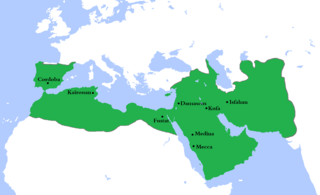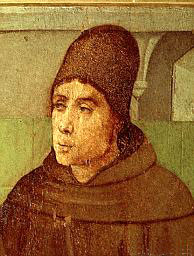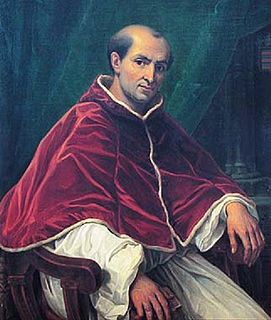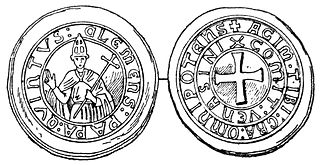Related Research Articles

The Immaculate Conception is a dogma of the Catholic Church which states that Mary, mother of Jesus has been free of original sin from the moment of her conception. It proved controversial in the Middle Ages, but was revived in the 19th century and was adopted as Church dogma when Pope Pius IX promulgated Ineffabilis Deus in 1854. This followed Ubi primum, an 1849 encyclical wherein Pius had asked the bishops for their opinions on the matter, resulting in overwhelming support from the Church's hierarchy.

Pope Clement V, born Raymond Bertrand de Got, was head of the Catholic Church and ruler of the Papal States from 5 June 1305 to his death in April 1314. He is remembered for suppressing the order of the Knights Templar and allowing the execution of many of its members. Pope Clement V was the pope who moved the Papacy from Rome to Avignon, ushering in the period known as the Avignon Papacy.
Pope Zachary was the bishop of Rome from December 741 to his death. He was the last pope of the Byzantine Papacy. Zachary built the original church of Santa Maria sopra Minerva, forbade the traffic of slaves in Rome, negotiated peace with the Lombards, and sanctioned Pepin the Short's usurpation of the Frankish throne from Childeric III. Zachary is regarded as a capable administrator and a skillful and subtle diplomat in a dangerous time.

Boniface, born Winfrid in the Devon town of Crediton in Anglo-Saxon England, was a leading figure in the Anglo-Saxon mission to the Germanic parts of the Frankish Empire during the 8th century. He organised significant foundations of the church in Germany and was made archbishop of Mainz by Pope Gregory III. He was martyred in Frisia in 754, along with 52 others, and his remains were returned to Fulda, where they rest in a sarcophagus which became a site of pilgrimage. Boniface's life and death as well as his work became widely known, there being a wealth of material available—a number of vitae, especially the near-contemporary Vita Bonifatii auctore Willibaldi, legal documents, possibly some sermons, and above all his correspondence. He is venerated as a saint in the Christian church and became the patron saint of Germania, known as the "Apostle to the Germans".

Year 744 (DCCXLIV) was a leap year starting on Wednesday of the Julian calendar. The denomination 744 for this year has been used since the early medieval period, when the Anno Domini calendar era became the prevalent method in Europe for naming years.

Berengar of Tours, in Latin Berengarius Turonensis, was an 11th-century French Christian theologian and archdeacon of Angers, a scholar whose leadership of the cathedral school at Chartres set an example of intellectual inquiry through the revived tools of dialectic that was soon followed at cathedral schools of Laon and Paris. He came into conflict with Church authorities over the doctrine of transubstantiation of the Eucharist.

The Third Council of Constantinople, counted as the Sixth Ecumenical Council by the Eastern Orthodox and Catholic Churches, as well by certain other Western Churches, met in 680–681 and condemned monoenergism and monothelitism as heretical and defined Jesus Christ as having two energies and two wills.

Jansenism was a theological movement within Catholicism, primarily active in France, that emphasized original sin, human depravity, the necessity of divine grace and predestination. It was declared a heresy in the Catholic Church. The movement originated from the posthumously published work of the Dutch theologian Cornelius Jansen, who died in 1638. It was first popularized by Jansen's friend Abbot Jean du Vergier de Hauranne, of Saint-Cyran-en-Brenne Abbey, and, after du Vergier's death in 1643, was led by Antoine Arnauld. Through the 17th and into the 18th centuries, Jansenism was a distinct movement away from the Catholic Church. The theological center of the movement was the convent of Port-Royal-des-Champs Abbey, which was a haven for writers including du Vergier, Arnauld, Pierre Nicole, Blaise Pascal and Jean Racine.

Carloman was the eldest son of Charles Martel, majordomo or mayor of the palace and duke of the Franks, and his wife Chrotrud of Treves. On Charles's death (741), Carloman and his brother Pepin the Short succeeded to their father's legal positions, Carloman in Austrasia, and Pepin in Neustria. He was a member of the family later called the Carolingians and it can be argued that he was instrumental in consolidating their power at the expense of the ruling Merovingian kings of the Franks. He withdrew from public life in 747 to take up the monastic habit, "the first of a new type of saintly king," according to Norman Cantor, "more interested in religious devotion than royal power, who frequently appeared in the following three centuries and who was an indication of the growing impact of Christian piety on Germanic society".

The pallium is an ecclesiastical vestment in the Roman Catholic Church, originally peculiar to the pope, but for many centuries bestowed by the Holy See upon metropolitans and primates as a symbol of their conferred jurisdictional authorities, and still remains a papal emblem. In its present (western) form, the pallium is a long and "three fingers broad" (narrow) white band adornment, woven from the wool of lambs raised by Trappist monks. It is donned by looping its middle around one's neck, resting upon the chasuble and two dependent lappets over one's shoulders with tail-ends (doubled) on the left with the front end crossing over the rear. When observed from the front or rear the pallium sports a stylistic letter 'y'. It is decorated with six black crosses, one near each end and four spaced out around the neck loop. At times the pallium is embellished fore and aft with three gold gem-headed (dull) stickpins. The doubling and pinning on the left shoulder likely survive from the Roman pallium. The pallium and the omophor originate from the same vestment, the latter a much larger and wider version worn by Eastern Orthodox and Eastern Catholic bishops of the Byzantine Rite. A theory relates origination to the paradigm of the Good Shepherd shouldering a lamb, a common early Christian art image — but this may be an explanation a posteriori, however the ritual preparation of the pallium and its subsequent bestowal upon a pope at coronation suggests the shepherd symbolism. The lambs whose fleeces are destined for pallia are solemnly presented at altar by the nuns of the convent of Saint Agnes outside the walls and ultimately the Benedictine nuns of Santa Cecilia in Trastevere weave their wool into pallia.

Scotism is the philosophical and theological system or school named after 13th century Scottish philosopher-theologian John Duns Scotus. The word comes from the name of its originator, whose Opus Oxoniense was one of the most important documents in medieval philosophy and Roman Catholic theology, defining what would later be declared the Dogma of the Immaculate conception by Pope Pius IX in his constitution Ineffabilis Deus on 8 December 1854.
Aldebert, or Adalbert, was a preacher in 8th century Gaul. He claimed that an angel had conferred miraculous powers on him at his birth and that another had brought him relics of great sanctity from all parts of the earth. He also claimed to be able to see the future and read people's thoughts, telling those who came to him that they had no need to confess, since he knew what they had done, and that their sins were forgiven.

Virgil, also spelled Vergil, Vergilius, Virgilius, Feirgil or Fergal, was an Irish churchman and early astronomer. He left Ireland around 745, intending to visit the Holy Land; but, like many of his countrymen, who seemed to have adopted this practice as a work of piety, he settled in Francia. Vergilius served as abbot of Aghaboe, bishop of Ossory and later bishop of Salzburg. He was called "the Apostle of Carinthia" and "the geometer".

The Italian Catholic Archdiocese of Benevento has a long history; it now has five suffragan dioceses: the diocese of Ariano Irpino-Lacedonia, the diocese of Avellino, the diocese of Cerreto Sannita-Telese-Sant'Agata de' Goti, the Territorial Abbey of Montevergine, and the archdiocese of Sant'Angelo dei Lombardi-Conza-Nusco-Bisaccia.

Abel was a saint and suffragan bishop of Reims in Francia, modern-day France.

The Catholic Diocese of Pitigliano-Sovana-Orbetello is a Latin suffragan see in the ecclesiastical province of the Metropolitan Archdiocese of Siena-Colle di Val d'Elsa-Montalcino, in Tuscany. The diocese of Sovana had originally been directly dependent upon the Holy See, and its bishops attended the pope's synods. When Pope Pius II, who was a Piccolomini of Siena, created the metropolitan archdiocese of Siena, he made Sovana one of its suffragan dioceses. The bishops of Sovana usually resided in the former palace of the Orsini in Pitigliano, which was given to Bishop Francesco Pio Santi (1776–1789) by the Grand Duke of Tuscany.
Halinard was the Archbishop of Lyon between 1046 and 1052; he also served as abbot of the monastery of Saint-Bénigne in Dijon between 1031 and 1052. He was a counselor of both the Emperor Henry III and Pope Victor II.

The 1304–1305 papal conclave, held in Perugia, was the protracted papal conclave that elected non-cardinal Raymond Bertrand de Got as Pope Clement V. This immediately preceded the beginning of the Avignon Papacy.

The medieval University of Dublin was an early but unsuccessful attempt to establish a university in Dublin, the capital city of the Lordship of Ireland. Founded in 1320, it maintained an intermittent existence for the next two centuries, but it never flourished, and disappeared for good at the Reformation in Ireland (1534–41). It was located in Saint Patrick's Cathedral, Dublin. It had no connection with the present University of Dublin, better known as Trinity College Dublin, which was founded in 1592.

Gentile Portino da Montefiore was an Italian Franciscan friar and prelate, who was created Cardinal-Priest of Santi Silvestro e Martino ai Monti by Pope Boniface VIII in 1300. He served as Major Penitentiary of the Roman Curia from 1302 to 1305. Pope Clement V sent him to Hungary as a papal legate in 1308, with the primary task of assuring the Angevins the Hungarian throne. Gentile built the San Martino Chapel in the Lower Basilica of Saint Francis of Assisi, dedicated to Saint Martin of Tours. He was buried in the neighboring Chapel of St. Louis.
References
![]() This article incorporates text from a publication now in the public domain : "Clement Scotus I". Dictionary of National Biography . London: Smith, Elder & Co. 1885–1900.
This article incorporates text from a publication now in the public domain : "Clement Scotus I". Dictionary of National Biography . London: Smith, Elder & Co. 1885–1900.